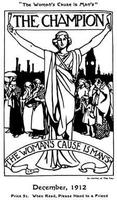Women's Suffrage
WOMEN'S SUFFRAGE was achieved after a long campaign that began in the 1870s. Women in BC cities were first allowed to vote for school trustees in 1884, if certain property qualifications were met, and in 1889 they were allowed to stand for election themselves. They lost these rights in 1891, but new legislation the following year allowed women of means and property to vote. In 1895 women in cities could be elected school trustees if they owned property; the first woman so elected was Maria GRANT in VICTORIA. Meanwhile MLAs unsuccessfully attempted to pass legislation giving women the provincial vote. In 1906 a loophole in an amendment to the Municipal Elections Act permitted women to vote in municipal elections. Victoria women exercised that right for the first time in the civic election of 1907, but the loophole was removed in 1908, and so was the vote.
In 1910 the Political Equality League formed to lobby for suffrage. It published its own newspaper, Champion, and organized chapters across the province. The opposition LIBERAL PARTY endorsed women's suffrage in 1912 but the CONSERVATIVE government of Richard McBRIDE held out against it. Finally the new premier, William BOWSER, put the issue to referendum during the provincial election of 1916. It passed, and the newly elected Liberal government enacted a bill giving women the provincial vote and the right to run for office as of 5 Apr 1917. They could also vote in municipal elections. BC was the fourth province, after Manitoba, Saskatchewan and Alberta, to grant women the vote.
The federal franchise was granted in 1917 to women in the armed forces and to female relatives of military men. It was extended to all women aged 21 years and older on 24 May 1918. In July 1919 women gained the right to run for federal office, though they were not eligible for appointment to the Senate until 1929.

